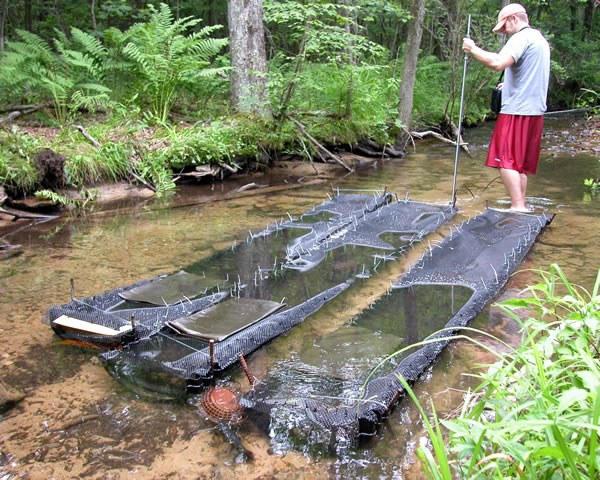Researchers in the School conducted a study to determine if the millions of nonnative trout stocked for Pennsylvania anglers have affected the state's native aquatic organisms.

An undergraduate student measures stream flow in a trout enclosure; Photo by Caleb Tzilkowski.
Nonnative trout have had obvious detrimental impacts on native fish, amphibians, and invertebrates elsewhere, so researchers in the School wondered if brown and rainbow trout stocked by the Pennsylvania Fish and Boat Commission affect the state's stream life differently than native brook trout.
Dr. Jay R. Stauffer, Jr., distinguished professor of ichthyology, and then doctoral student Caleb Tzilkowski conducted a study that considered brown trout effects because rainbow trout rarely establish breeding populations in Pennsylvania. Brown trout, on the other hand, spawn in many Commonwealth streams and wild populations are common. It is not unusual for wild browns and brook trout to coexist in the same headwater stream. Many wild brook trout populations have been there for thousands of years, whereas the wild browns are descendants of stocked fish that were able to survive and reproduce.
This study suggested that although brown trout and brook trout are important predators in headwater streams, their effects on the studied food webs were very similar.
Data was also gathered for another study aimed at restoring endangered shiner populations in the Brodhead Creek watershed in Monroe County. Trout have been stocked each spring into the only stream (Marshalls Creek) where the endangered shiners occur in the state, and because shiners are known to be excellent trout bait, the researchers took an interest in how many of the endangered shiners stocked trout eat. Stomach contents of stocked brook and rainbow trout and wild brown trout from Marshalls Creek were identified. The results suggested that stocked trout do not pose an immediate threat to nongame fishes, but introduced trout that become established may.
While many fish population studies focus on species existing in exploited systems, data on unexploited fish populations can provide useful insight for fishery managers. Dr. Paola Ferreri, associate professor of fisheries management, conducted a study to describe the structure and dynamics of the unexploited yellow perch population in the Pymatuning Sanctuary in Crawford County. The age and size structures were found to be dramatically different for males and females collected on the spawning grounds. The abundance of small males collected is consistent with data from exploited systems, but the number of large, older females collected seems unique to unexploited systems. This research provides realistic boundary conditions for mathematical models that describe the response of yellow perch populations to different management strategies.

